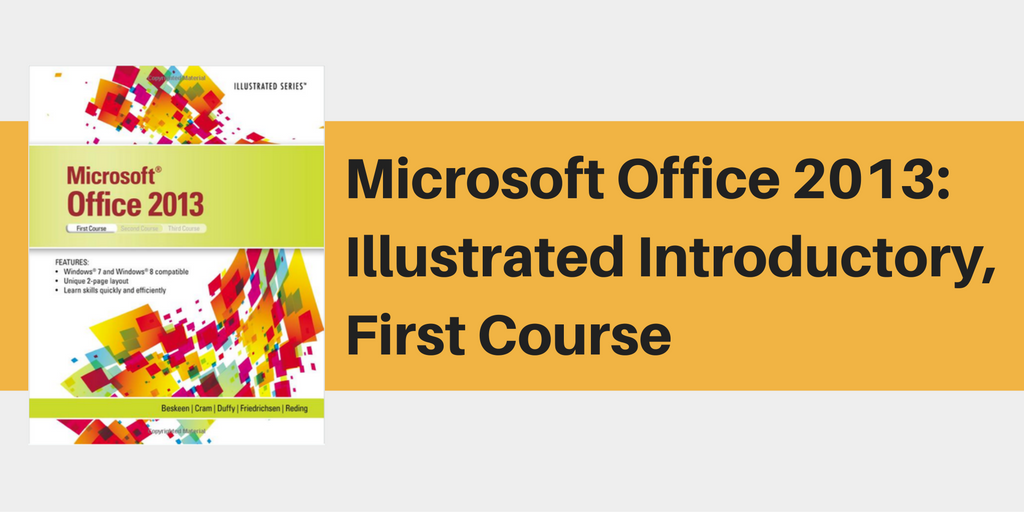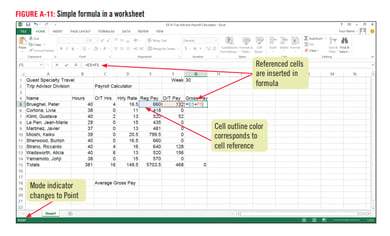Is There A Way To Get Data Files For Cengage 2013 Powerpoint?
Print/Save as PDF
Note from Bri: This is a invitee mail from Frank DiMaria, a center school computer teacher in Fort Manufactory, SC. Frank has written a number of manufactures nigh educational technology and tips for other computer teachers. At AES, when talking to teachers virtually Business concern&ITCenter21, nosotros are often asked questions about other resource for computer classes. In hopes of providing information to calculator teachers about other options out there, we asked Frank to provide an in-depth review of the computer applications textbook he uses. I hope y'all discover Frank'south review helpful and informative! Within hours of signing my first contract every bit a reckoner teacher I was at the local Barnes & Noble searching for a textbook to employ in my classroom. I didn't find one. And so, I turned to the Internet. Still, no textbook. Information technology was 2002 and few schools were offering computer classes and textbook publishers were non stopping their presses to print figurer textbooks. Now, nigh xv years later, several publishers have moved into the middle school textbook infinite for computer classes. Last April the middle school computer teachers in my commune attended a textbook caravan to consider adopting a new figurer applications textbook. We came abroad with samples of the following options for consideration : Business&ITCenter21 by Practical Educational Systems ; A Guide to Microsoft Office 2013, 1st Edition past EMC Publishing LLC ; Learning Microsoft Office 2013, Level one by Pearson Didactics, Inc. publishing as Prentice Hall ; and Microsoft Office 2013: Illustrated Introductory, Starting time Course by Cengage . After careful consideration - some might say heated discussions - we chose the Cengage title. I've lived with this textbook for twelve weeks and at present it's time to offer an unbiased review of this championship. The Microsoft Part 2013: Illustrated Introductory, First Class textbook offers students detailed procedures, colorful screen captures, and plenty of practical, hands-on assignments. Among its list of teacher resources are learning upshot maps, a teacher manual, a sample syllabus, solution files, and exam test banks. At the end of each unit at that place is a concepts review and several contained challenges for students. The book begins with a unit on Computer Concepts, which covers the digital globe we alive in, memory, storage, output devices, and and then on. The side by side three sections hash out Windows 8 features, File Management, Cyberspace Explorer, and Microsoft Office 2013 Suite features. In the sections that follow, which I consider the meat of the text, the volume features units on: In addition, this Cengage title offers 10 Capstone Projects: ii for each of the four major software applications and two integration projects. The units of this Cengage textbook are laid out exceptionally well with a professional theme running throughout the book. Students taking the course "work" for a fictitious visitor called Quest Specialty Travel . The spreadsheets, documents, presentations, and databases all relate to professional person tasks associated with this company. Each unit comprises a host of procedures that guide students to the learning objectives for that unit. Each procedure is ane folio long and e'er begins on the even numbered page. That means that as students are viewing the procedure on the left side of the spine (the even page), they tin can readily run across the screenshots (figures) with arrows and callouts indicating cardinal steps in the process on the odd or opposite page. They don't have to turn between pages every bit they complete a lesson. Students thrive on routine and repetition. Cengage did a great task making each lesson the same length and using the aforementioned layout for each. This strategy allows students to become familiar and more comfortable with the text quicker than if each lesson were laid out differently. To complete the stride-by-step lessons featured in the textbook, students utilise a ready of data files. The textbook comes with a Student CD that contains a consummate prepare of the data files students use to complete each lesson, a ready of solution files (that show what a file should wait similar when a student completes it correctly), and a set of annotated files. The annotated files evidence y'all what a correctly completed file looks like, with extra information. Using textbox bubbling and arrows, the annotated files indicate exactly what students demand to do to in order to modify the original file and complete the lesson. The student data file names are listed on the first page of each unit. As students work through the lessons they are instructed to open the files every bit necessary, rename them with a specific name (which I changed to friction match my naming protocol), and save them to a location of the teacher'due south choice. This textbook does an infrequent task of indicating the results of every procedural step and lets the students know what they can ignore or what is extraneous within a given scenario. Afterward each numbered step, students get a brief explanation of what should happen if they follow the procedure correctly. Explanations refer to figures (screenshots) on the contrary page so students can run into what their document, spreadsheet, or presentation volition look like if they follow the procedure correctly. The Microsoft Office 2013: Illustrated Introductory, First Grade textbook includes many tips and helpful details for students. In the margin of each procedure folio teachers and students find Quick Tips and Trouble Warnings. These road signs point to specific steps and bespeak alternative ways to accomplish a task or warn students how to correct errors they may have made in a previous pace. For example, in a procedure in which students are learning how to copy and paste text, a Problem Warning reminds them that they can click Undo if they accidentally moved the text instead of copied and pasted it. The authors lay in enough of these quick tips and warnings to enrich the learning experience, simply not likewise many that they detract from it. Within procedural steps the actions are clearly indicated in a dark-green font. For instance, when a student is instructed to click Cut , the activeness appears in greenish. Likewise, keystrokes are indicated with brackets. For case, press [Ctrl][Dwelling house] . At the lesser of some procedure pages students find Clues to Apply. These xanthous boxes offer tips on accomplishing tasks beyond the procedure. For instance, in the re-create and paste procedure the Clues to Use box offers information on splitting the document window to re-create and paste inside a long document. Students will not likely use these clues as they are taking the grade, but they volition surely benefit from them as they motility beyond the textbook and complete more complex tasks. Clues to Use from Microsoft Function 2013: Illustrated Introductory, Showtime Form In addition to the student content, the companion Teacher CD contains an instructor manual that offers lecture notes that summarize each section, figures and boxes plant in the section, teacher tips, classroom activities, and lab activities. This textbook also comes with a set of rubrics. You tin can use these rubrics to class the skills reviews at the end of each unit. Considering the rubrics are Word documents, you can make full them out electronically or print them and manually mark them up. I constitute it curious that the rubrics practise not take a space for the student'south proper noun, just have spaces for the professor's name, grade, notes, and indicate the solution file proper noun. To familiarize myself with the textbook and in particular the information files, annotated files, and solution files, I printed a set of each and newspaper clipped them to each unit. Equally I become more comfortable with the book, this volition non be necessary. Using the Cengage text, there aren't many downsides... but in that location is room for improvement to save the teacher time and provide better clarity. I retrieve Cengage should have listed the solution files on the start page of each unit next to the student data files. Maybe they could have presented all the files in a table then the instructor could see which solutions files are associated with which student information files. Although it was relatively piece of cake to locate the solution files on the CD, I had to flip through the textbook page by page and physically highlight the names of the solution files within each procedure so I can locate them while I was pedagogy. Besides, Cengage could have done a ameliorate task cross-referencing the solution files to the pages on which those files are used in each unit. For the most role, Cengage did a great job making the educatee data files and the teacher solution files available and accessible. The only other downside I found using this book with students is that the pages are not numbered 1 through 315. Rather, the authors decided to restart numbering each unit from one. To draw a student'south attention to the procedure on Adding Slide Footers they have to kickoff locate the PowerPoint unit past color (it happens to be orange) then find page 40 within that unit. I find that when working with students it'southward e'er easier to have ane page 40 rather than a page 40 in every single unit. Adopting a new textbook or a new technology seldom comes without a learning bend, and adopting this text is no exception. For the by 16 years, I've taught without a textbook, creating my own lessons with solution files (I telephone call them models). I present those lessons as follows: Every now and again I'll find a lesson on the Internet or choice one upwardly from a colleague, simply for the well-nigh part the lessons I teach I've created out of necessity. When nosotros adopted this text the first question I asked myself was: " How will this textbook fit into my well-established curriculum? " As this school year unfolds I'm getting a clearer idea. For now I'm content to nowadays the units in Microsoft Function 2013: Illustrated Introductory, First Course as guided educational activity. I read each stride of each procedure to my students and model them on the SMART Board every bit they follow along in their textbooks and consummate the tasks on their computers. In the past I've used written procedures to teach. However, I found my eye school students were not receptive them. They preferred an in-person lecture, guided teaching, or a recorded tutorial. (I've made tutorials of all my lessons using the SMART recorder for use as enrichment or when students are absent). Overall I requite Cengage a skillful solid "A" for this Microsoft Office textbook. My colleagues and I chose it after careful consideration, and in my opinion information technology lives up to my expectations. I await forward to finding new means to integrate it into my curriculum next semester and in the years to come.
An Overview of the Cengage Microsoft Office 2013 Textbook

What Does the Cengage Microsoft Office Textbook Content Wait Similar?
 Sample Figure from the Microsoft Office 2013: Illustrated Introductory, First Course Text
Sample Figure from the Microsoft Office 2013: Illustrated Introductory, First Course Text Aid for Students: Quick Tips, Problem Warnings, Activeness Indicators, & Clues to Utilise
Quick Tips & Trouble Warnings:
 Trouble Alert from Microsoft Office 2013: Illustrated Introductory, First Form
Trouble Alert from Microsoft Office 2013: Illustrated Introductory, First Form Action Indicators:
Clues to Use:

Additional Resource for the Teacher
How Can the Cengage Middle School Textbook exist Improved?
My Suggested Improvements for Solution Files:
My Suggested Improvement for Better Page Numbering:

Fitting the Text into my Existing Reckoner Curriculum
Is There A Way To Get Data Files For Cengage 2013 Powerpoint?,
Source: https://www.aeseducation.com/blog/2016/11/computer-teacher-review-cengage-middle-school-textbook
Posted by: bourgeoisspait1961.blogspot.com


0 Response to "Is There A Way To Get Data Files For Cengage 2013 Powerpoint?"
Post a Comment